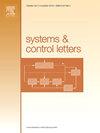群结构稀疏反馈镇定的平滑梯度方法
IF 2.1
3区 计算机科学
Q3 AUTOMATION & CONTROL SYSTEMS
引用次数: 0
摘要
我们研究了线性系统的群结构稀疏反馈镇定增益矩阵的设计问题,该增益矩阵具有同时减少有效测控点和通信点数量的优点。基本思想是定义一个矩阵范数来评估增益矩阵的一般稀疏性,但也测量零行和零列。为了利用这一度量,我们利用状态转移矩阵的积分性能将群结构稀疏反馈镇定问题表述为一个带有凸惩罚的优化问题。针对所得到的问题不光滑的特点,提出了一种平滑梯度算法,在适当的参数选择下,有效地解决了群稀疏优化问题,并保证了收敛性。最后,通过数值算例说明了该方法的有效性。本文章由计算机程序翻译,如有差异,请以英文原文为准。
Smoothing gradient method for group-structured sparse feedback stabilization
We investigate the problem of designing group-structured sparse feedback stabilization gain matrix for linear systems that come with the advantage of simultaneously reducing the numbers of active points of measurements and control as well as communication. The basic idea is to define a matrix norm that evaluates the sparsity of the gain matrix in general but also measures zero rows and zero columns. To make use of this measure, we use the integral performance of the state transition matrix to formulate the group-structured sparse feedback stabilization problem as an optimization problem with a convex penalty. Since the resulting problem is non-smooth, a smoothing gradient algorithm is proposed to solve the group sparse optimization problem efficiently with a convergence guarantee under suitable parameter choices. Finally, numerical examples are provided to illustrate the effectiveness of the approach.
求助全文
通过发布文献求助,成功后即可免费获取论文全文。
去求助
来源期刊

Systems & Control Letters
工程技术-运筹学与管理科学
CiteScore
4.60
自引率
3.80%
发文量
144
审稿时长
6 months
期刊介绍:
Founded in 1981 by two of the pre-eminent control theorists, Roger Brockett and Jan Willems, Systems & Control Letters is one of the leading journals in the field of control theory. The aim of the journal is to allow dissemination of relatively concise but highly original contributions whose high initial quality enables a relatively rapid review process. All aspects of the fields of systems and control are covered, especially mathematically-oriented and theoretical papers that have a clear relevance to engineering, physical and biological sciences, and even economics. Application-oriented papers with sophisticated and rigorous mathematical elements are also welcome.
 求助内容:
求助内容: 应助结果提醒方式:
应助结果提醒方式:


